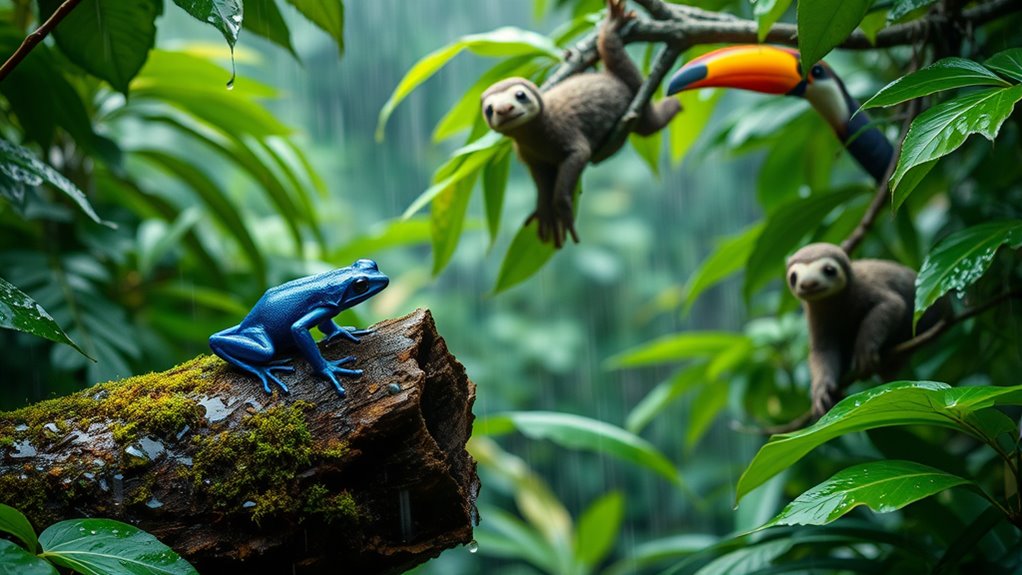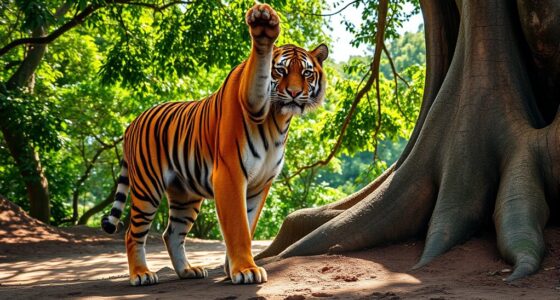Animals survive in the rainforest through various adaptations. They use camouflage to blend in with their surroundings, helping them evade predators and ambush prey. Nocturnal behaviors reduce competition and encounters with threats. Many species also engage in mutualistic relationships, like bees pollinating flowers while feeding on nectar. This interdependence strengthens ecosystems. You'll discover even more fascinating survival strategies the rainforest's inhabitants employ, showcasing their incredible resilience in such a challenging environment.
Key Takeaways
- Camouflage helps animals like jaguars and poison dart frogs evade predators and ambush prey effectively.
- Nocturnal behavior in species such as sloths and Amazon tree boas reduces competition and exposure to daytime predators.
- Many animals, including howler monkeys, use vocalizations to establish territory and communicate with others for resource management.
- Mutualistic relationships, like bees pollinating flowers and ants protecting mealybugs, enhance survival and ecosystem health.
- Biodiversity in the rainforest ensures resilience and stability, supporting various species and preventing extinction through interdependence.
How Do Animals Adapt to Live in the Tropical Rainforest?
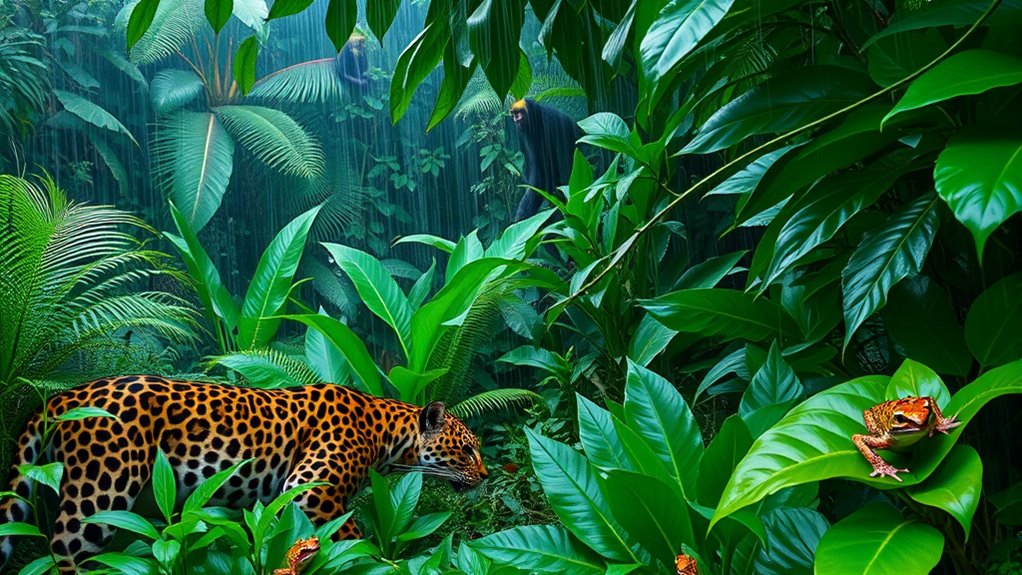
While traversing the lush and diverse environment of the tropical rainforest, animals have developed remarkable adaptations to survive. Many animals use camouflage, like jaguars with their spotted fur or walking stick insects that resemble twigs, enhancing their ability to blend into the surroundings. This skill helps them avoid predators and ambush prey effectively.
Additionally, some species have adapted their activity patterns; for instance, the Amazon tree boa hunts at night, while monkeys forage during the day. Poisonous creatures, such as poison dart frogs, possess toxic skin to fend off threats, while some snakes have evolved venom to capture their food.
The interdependence among species further exemplifies the intricate survival strategies that thrive in this vibrant habitat.
Which Adaptations Are Most Helpful in a Tropical Rainforest?
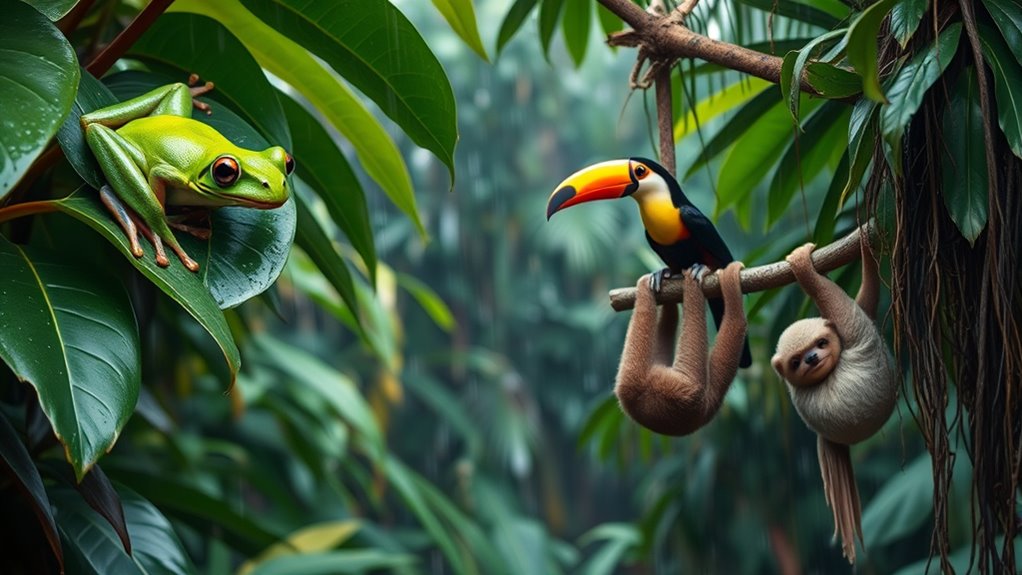
In the tropical rainforest, specific adaptations play a significant role in an animal's survival.
Camouflage is essential; animals like jaguars and leaf-tailed geckos blend into their surroundings, evading predators while ambushing prey.
Camouflage is vital for survival, allowing jaguars and leaf-tailed geckos to evade threats and stealthily hunt.
Nocturnal behavior, seen in species like the Amazon tree boa, allows you to hunt at night when competition is lower.
Many rainforest species, such as poison dart frogs, develop toxins to kill or deter predators, enhancing their chances of survival.
Additionally, timing your activity—whether you're nocturnal or diurnal—can improve resource acquisition and reproductive success.
Interdependence among species also supports survival, as caterpillars rely on ants for protection while providing food in return, showcasing how these adaptations work together in this competitive ecosystem.
What Kind of Animals Live in Tropical Rainforests?

When you think about tropical rainforests, imagine the incredible variety of animals that call them home.
You'll find fascinating mammals like jaguars and sloths, vibrant birds such as toucans, and unique reptiles and amphibians thriving in this lush environment.
Each group plays a crucial role in maintaining the ecosystem's balance.
Mammals of Rainforests
Tropical rainforests host an astounding variety of mammals, each uniquely adapted to thrive in this lush environment.
For instance, jaguars have evolved powerful bodies and spotted fur, allowing them to use camouflage to stealthily hunt their prey under the forest canopy.
Sloths, on the other hand, have developed a slow metabolism and a specialized diet of leaves, enabling them to live high in the trees without fierce competition for food.
Howler monkeys use their loud vocalizations to establish territory and communicate with others in the dense foliage.
Many rainforest mammals exhibit nocturnal behaviors to protect themselves from predators and reduce daytime competition for food.
This fascinating adaptability showcases the resilience of life in one of Earth's most vibrant ecosystems.
Reptiles and Amphibians
Reptiles and amphibians thrive in the humid embrace of rainforests, showcasing remarkable adaptations that allow them to flourish in this vibrant ecosystem.
Iconic animal species like the green tree frog and poison dart frog use their bright colors and toxic skin to deter predators. The green iguana expertly navigates the dense canopy with its strong limbs and prehensile tail, while the nocturnal Amazon tree boa relies on camouflage to avoid detection as it hunts.
Amphibians like certain salamanders and toads engage in mutualistic relationships with insects and plants, playing a vital role in the ecosystem's food web.
Together, these reptiles and amphibians contribute to the rich biodiversity and intricate balance of life in tropical rainforests.
Birds of the Canopy
In the lush layers of the rainforest canopy, a dazzling variety of birds thrive, each uniquely adapted to their vibrant environment.
Parrots, toucans, and hummingbirds fill the air with color, their bright feathers not just for show but also provide essential camouflage from predators among the dappled light.
These birds exhibit remarkable adaptability, with diets ranging from fruits and nectar to small animals, allowing them to exploit abundant food sources.
Species like orioles and tanagers even form mutualistic relationships with flowering plants, aiding in pollination while they feed.
Their strong wings and agile flight patterns enable them to navigate dense foliage, ensuring they can escape danger and access hard-to-reach treasures in their thriving rainforest home. Additionally, some birds utilize antioxidants from honey found in their habitat to boost their immune systems, helping them stay healthy amidst the challenges of rainforest life.
Camouflage Adaptations
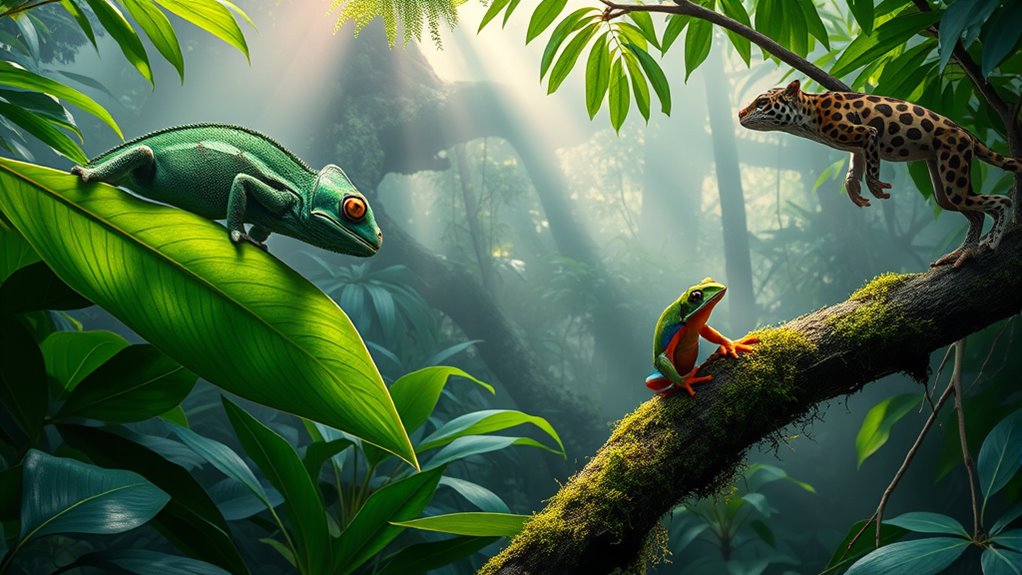
In the rainforest, animals like jaguars and leaf-tailed geckos use camouflage to blend with their surroundings, making it tough for others to spot them.
This clever adaptation not only helps them avoid predators but also boosts their success when hunting.
Blending With Environment
While traversing the vibrant and complex world of the rainforest, you might notice how expertly animals use camouflage to blend into their surroundings. This adaptation not only helps them avoid detection by predators but also aids in ambushing prey. For instance, jaguars' spotted fur mimics the dappled forest floor, while walking stick insects resemble twigs. Leaf-tailed geckos take it a step further by mimicking leaves and bark.
| Animal | Camouflage Type | Purpose |
|---|---|---|
| Jaguar | Spotted fur | Avoid detection |
| Walking Stick Insect | Twig-like appearance | Avoid detection |
| Leaf-tailed Gecko | Leaf and bark mimicry | Avoid detection |
These strategies are essential for survival in the rainforest's competitive environment.
Predatory Ambush Strategies
Camouflage plays a significant role in predatory ambush strategies within the rainforest, where the dense foliage makes stealth essential for hunting success.
For instance, jaguars blend their spotted fur with the dappled light, allowing them to approach unsuspecting prey undetected. Similarly, walking stick insects mimic twigs, making it hard for predators to spot them, while leaf-tailed geckos resemble leaves to avoid detection and ambush insects.
This remarkable camouflage not only helps these predators evade their own threats but also enhances their ability to catch meals. In the ever-competitive environment of the rainforest, these adaptations are critical for survival, showcasing the intricate dynamics of predator-prey relationships and the continuous evolution of these essential traits.
Nocturnal & Diurnal Modes

How do animals in the rainforest adapt their behaviors to thrive in such a competitive environment? You'll find that nocturnal animals, like the Amazon tree boa and certain frogs, come alive at night to dodge predators and lessen competition. In contrast, diurnal creatures such as toucans and monkeys seize the daylight to forage for food.
| Nocturnal Animals | Diurnal Creatures |
|---|---|
| Active at night | Active during the day |
| Enhanced night vision | Bright colors for communication |
| Avoids daytime predators | Forages in sunlight |
| Examples: Frogs, Boas | Examples: Toucans, Monkeys |
| Reduced competition | Visibility aids for mating |
This separation of activity times keeps the ecosystem balanced, allowing diverse species to coexist successfully.
Mutualism and Interdependence in Ecosystems
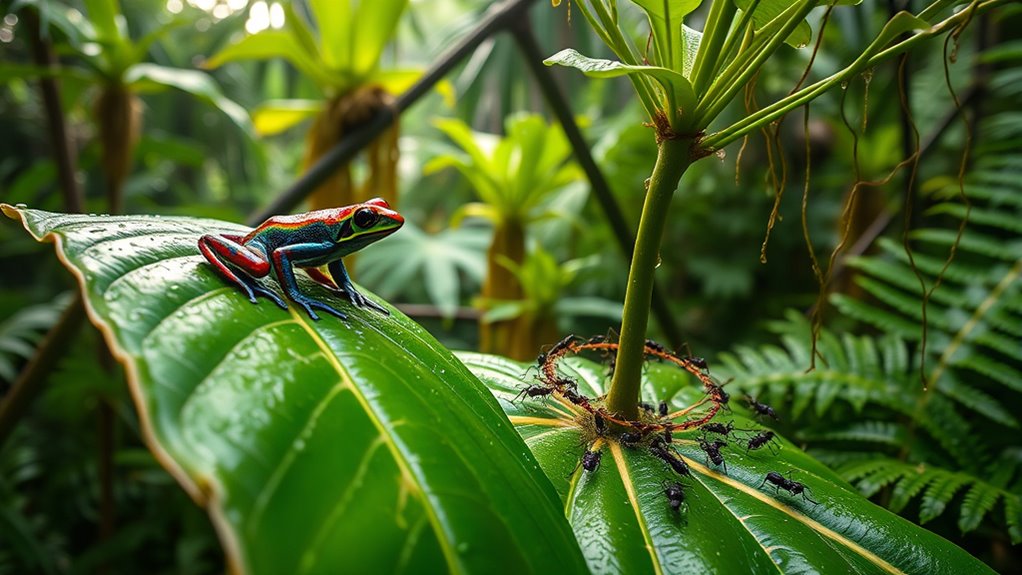
In the vibrant world of tropical rainforests, mutualism and interdependence play vital roles in the ecosystem's health. You'll see fascinating relationships where two species benefit from each other.
For instance, bees pollinate flowers while munching on nectar, showcasing mutualism. Mealybugs produce honeydew for ants, who protect them from predators, highlighting interdependence. Caterpillars also rely on ants for safety, while providing them with food resources.
Birds feast on fruits and help disperse seeds, further demonstrating mutualism and aiding tree reproduction. These interdependent relationships are important for maintaining the balance and health of rainforest ecosystems, supporting biodiversity and species survival.
Frequently Asked Questions
What Are 5 Examples of Animal Adaptations in Animals?
You can find fascinating examples of animal adaptations all around you.
For instance, jaguars' spotted fur helps them blend into their surroundings, while walking stick insects mimic twigs for camouflage.
Nocturnal animals like the Amazon tree boa hunt at night to avoid competition.
Poison dart frogs have toxic skin to deter predators, and some caterpillars form mutualistic relationships with ants for protection.
These adaptations are essential for survival in their respective environments.
What Do Animals Need to Survive in the Forest?
You might think survival is just about finding food, but animals need more than that in the forest.
They require consistent access to food sources, like fruits and insects, along with plenty of water for hydration.
Shelter is essential too, offering protection from predators and harsh weather.
Plus, adaptations like camouflage help them blend in, while social structures guarantee they thrive together.
All these elements create a balanced ecosystem for survival.
What Are 5 Facts About Rainforest Animals?
You'll find that rainforest animals are incredibly diverse and fascinating.
First, about 50% of Earth's species live in these ecosystems.
Second, camouflage helps predators like jaguars and leaf-tailed geckos blend in.
Third, some creatures, like poison dart frogs, have toxic skin for defense.
Fourth, mutualism is essential, with ants and mealybugs forming partnerships.
Finally, animals often adapt their behaviors, like nocturnal hunting by the Amazon tree boa and daytime activities by parrots.
How Do Animals Stay Cool in the Rainforest?
Imagine you're in a lush jungle, where vibrant leaves form a protective blanket overhead.
Animals stay cool by seeking refuge in the canopy, where humidity helps regulate their body temperature. You'd notice sloths and monkeys hanging out high above the ground, avoiding the heat below.
At night, creatures like the Amazon tree boa come alive, basking in cooler air. Frogs use their permeable skin to retain moisture, while toucans splash in streams to cool off.
Conclusion
In the vibrant world of tropical rainforests, animals showcase incredible adaptations that help them thrive. Did you know that these ecosystems house about 50% of the world's plant and animal species, despite covering only 6% of Earth's surface? This astounding diversity highlights the importance of camouflage, varying activity patterns, and mutualistic relationships among species. By understanding these survival strategies, you'll gain a deeper appreciation for the intricate web of life that exists in these lush environments.
